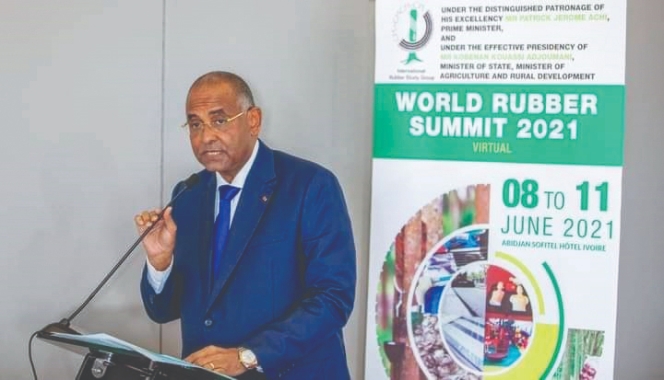
Covid 19 has impacted the global rubber sector, both big and small stakeholders, hard. This year’s edition of the World Rubber Summit will focus on redefining value chains.
“The summit will have two days of high-level presentations and interactive discussions on identifying pathways to redesign more resilient and sustainable value chains, both at the regional and global levels. It will also focus on the critical role that innovation and new technologies could play in mitigating the social, environmental and economic risks to which the rubber sector, like many others, is currently exposed. Visibility, transparency and data-sharing are critical for the 21st century supply chain,” says Salvatore Pinizzotto, Secretary-General, The International Rubber Study Group.
What would be the key focus for this year’s edition of WRS?
The International Rubber Study Group (IRSG) will organise the World Rubber Summit (WRS) in Singapore. The annual event will provide a unique and exclusive opportunity for global leaders to meet, share best practices and lay the foundations for future collaborations. The theme of the World Rubber Summit 2022 (WRS 2022) is ‘A Resilient, Digitalised and Sustainable Rubber Economy: Redefining Value Chains’.
To be held between 24 and 26 May in Singapore at the ParkRoyal on Beach Road, WRS 2022 will be a hybrid event like the previous editions.
The summit will have two days of high-level presentations and interactive discussions on identifying pathways to redesign more resilient and sustainable value chains, both at the regional and global levels. It will also focus on the critical role that innovation and new technologies could play in mitigating the social, environmental and economic risks to which the rubber sector, like many others, is currently exposed. Visibility, transparency and data-sharing are critical for the 21st century supply chain.
I believe this is the time when companies and organisations in the rubber sector should rethink their business model as conditions are changing and new opportunities arise. This is a nique opportunity for all stakeholders involved in the natural and synthetic rubber economy to be innovative to foster resilience, adaptability and long term sustainability.
Furthermore, in their journey towards a net-zero economy, businesses need to redefine, execute and evolve decarbonisation and offsetting plans for scope 1 and 2 emissions and potentially expand those plans to include scope 3 emissions. Integrate climate-related factors into decision-making processes for strategy, finance and capital spending and consider leading actions with others in the rubber industry and/or in their ecosystem of investors, supply chains, customers and regulators. In particular, financial institutions will have an important role to play in supporting large-scale capital reallocation. On the other hand, governments and multilateral institutions could use existing and new policy, regulatory and fiscal tools to establish incentives, support vulnerable stakeholders and foster collective actions.
I would like to take this opportunity to thank Enterprise Singapore, our strategic partner, for being this year, too, as every year when the event is organised in Singapore.Their inputs and contribution are very valuable and essential for IRSG.
Also, this year I am pleased to announce that the Nanyang Technology University (NTU) Singapore’s Agri-Food Innovation Lab (SAIL) will join the World Rubber Summit 2022 as Knowledge Partner. This is the first time for IRSG to have such a significant collaboration. It follows the decision taken by IRSG to participate and contribute to SAIL’s activities as a partner.
Last year, the African region was the focus, and this year it is Latin America. Could you share some information on the Latin American rubber industry and its contribution to the global rubber industry?
The 26th of May, the third day of the WRS 2022, will be dedicated to an entirely virtual side event on the rubber sector in Latin America organised by IRSG together with APABOR and Sociedad Latinoamericana de Tecnologia del Caucho (SLTC). Latin America is an area of growing importance for the world rubber economy, and it could play a relevant strategic role in shortening supply chains and making them more reliable. There are two trends that, in my view, need to be fully considered when we speak about rubber in Latin America. Firstly, the rubber sector is rapidly expanding in Brazil and other countries in that region, such as Guatemala and Colombia. There is an essential trend towards greater integration of the Latin American natural rubber market. Secondly, this is a region where the push towards product innovation and value-added could create a diversified market by exploiting various niche markets in the manufacturing sector such as auto parts, medical industry and even environmental services. In IRSG, we think it is really important to bring to the attention of the general public new developments that are occurring in the rubber economy because it helps to support this process towards innovation and highlight the strategic role that rubber has in the world economy and for our day-by-day life.
What are the main barriers to sustainable and inclusive growth in the rubber industry?
In the rubber economy, as in other sectors, we need to figure out effective forms of collaboration among stakeholders at local, national, regional and global levels to achieve sustainable and inclusive growth. Such partnerships will be able to identify and prioritise actions on the ground without forgetting a certain degree of coherence among the various interventions planned. Of course, this is not easy, because we have several numbers of producing countries; most of the production of natural rubber comes from smallholders, and there are long and complex supply chains. On top of this, new challenges need to be addressed, such as the impact of climate changes on natural rubber systems, a topic that IRSG, together with other leading organisations in the rubber sector (IRRDB, CIFOR/FTA and CIRAD), has decided to investigate since June 2020 and that has produced as an outcome the publication of a policy paper in December 2021. In addressing these issues, we need to have a holistic sectorial approach, with each stakeholder really providing its own skills and support, listening to each other and finding common solutions. The goal is not to leave anyone behind, so we need to pay special attention to smallholders and SMEs that might find it difficult, sometimes impossible, to put in place any sustainable practice and/or initiative. Although some improvements over the years have been achieved, working in this direction has not been an easy process. The pace and scale of this transition mean that today’s organisations and institutions need to be revamped, and maybe new ones created to disseminate best practices, establish standards and tracking mechanisms, drive capital deployment at scale, manage uneven impacts and support further coordination efforts. IRSG will continue to collaborate with other organisations to genuinely ensure that rubber could become an inclusive and sustainable economy.
All major rubber consumers, especially tyre companies, are talking about traceability, transparency and data sharing. Is it really happening in the rubber industry when small stakeholders dominate the more significant portion of the industry?
This process will require coordination, a vast amount of capital and large scale actions on the ground. The stakeholders in the rubber economy have the responsibility to ensure that these three factors will play a synergic role in increasing transparency and dramatically improving traceability. Innovative tools are already available, and more will come in the future, but we need to guarantee the long term wellbeing of smallholders. They need cost-effective support to apply consistently sustainable agriculture practices, have easier access to the market, IT infrastructures and adequate/updated education.
In this World Rubber Summit, IRSG is collaborating with the NextGen Leaders Programme 2021. Could you outline the goal and mission of this initiative?
The NextGen Leaders Programme 2021 has been launched by the IRSG secretariat to create a platform for engaging several ambitious young professionals in the rubber sector in national, regional and international activities and events. The programme participants are invited to collaborate with IRSG’s global rubber dialogue, support the development of balanced policy frameworks and help shape solutions for tomorrow’s rubber economy. The NextGen Rubber Leaders community builds on creative ideas and innovative potential for the next generation to challenge conventional thinking and explore new strategies for the future of the whole rubber economy. It offers young professionals a unique opportunity for learning and development with exposure to critical issues in the rubber debate. Currently, there are 10 participants in the programme covering the whole rubber value chain and from various countries (Singapore, Thailand, Germany, Australia, India, Sri Lanka and Brazil). The World Rubber Summit 2022 will be the first opportunity for them to go public. They will provide their effective contribution to the dialogue on the future of the rubber sector.
Korean Ministry Of Trade Commends Hankook Tire For Overseas Investment Excellence
- By TT News
- December 16, 2025
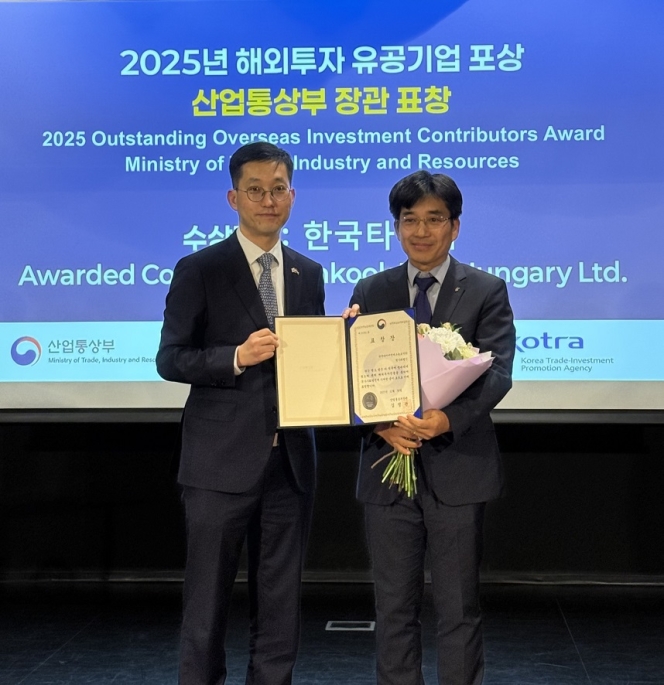
Hankook Tire has been honoured with a Ministerial Commendation by the Ministry of Trade, Industry and Resources of Korea. The honour was conferred at the 2025 Outstanding Overseas Investment Contributors Awards, an event hosted at the Korean Cultural Center in Budapest, Hungary, designed to recognise firms that enhance national competitiveness through global investment. During the ceremony, the company's leadership detailed its achievements to an audience of diplomatic officials and fellow Korean businesses operating in the region.
The award celebrated Hankook Tire's excellence across four critical areas. Economically, its strategic manufacturing base in Rácalmás, Hungary, established in 2008, has become a significant contributor to the Korean economy through consistent profit repatriation. The company has also acted as a catalyst for other Korean enterprises, enabling market entry for supply chain partners while securing its own strategic alliances within Europe, thereby strengthening the collective agility and global standing of Korean industry.
Beyond commerce, the company's deep local social commitment was highly recognised. The Hungarian plant is a cornerstone of the regional economy, having multiplied its local workforce to approximately 3,000 employees and maintaining this stability even through periods of global economic uncertainty. This commitment extends through extensive community outreach, including the long-term donation of tyres to enhance public and private mobility safety, alongside targeted investments in local infrastructure, social welfare and youth scholarships.
Furthermore, Hankook Tire serves as a central pillar for the Korean business community in Hungary. By holding leadership roles in major business associations, the company facilitates essential dialogue and practical cooperation, helping to resolve common challenges and support the sustainable operation of Korean enterprises in the market. Through this powerful combination of economic performance, social integration and community leadership, Hankook Tire exemplifies the impactful role of responsible overseas investment in fostering mutual growth and strengthening international ties.
Ho Taek Lim, Managing Director of Hankook Tire Hungary plant, said, “As a representative company with deep roots in Hungary, Hankook Tire is committed to fostering unity within the Korean community and supporting the successful establishment of Korean companies entering the market. Through close collaboration with local institutions, we will continue enhancing the competitiveness of Korean companies in Europe while advancing Korea’s national interests.”
Apollo Tyres Launches Vredestein Comtrac 2+ Van Tyre
- By TT News
- December 16, 2025
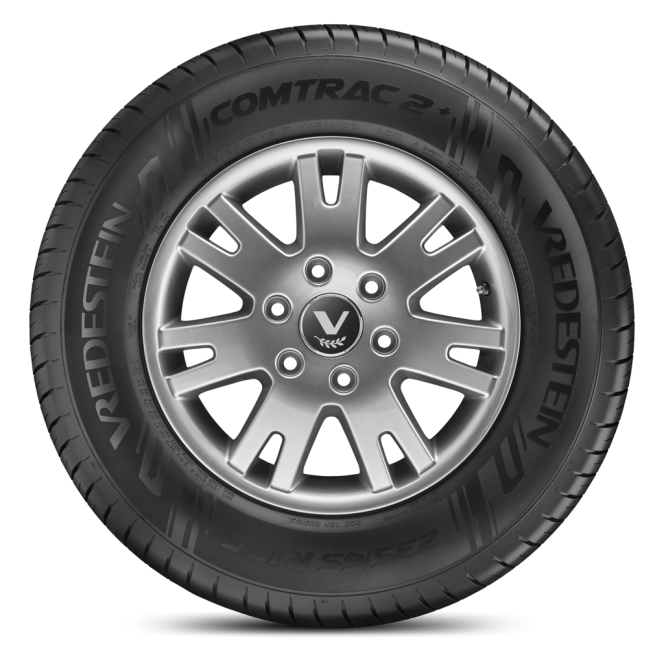
Apollo Tyres Ltd has introduced the Vredestein Comtrac 2+, a new summer tyre engineered for light commercial vehicles. Set for a European launch in January 2026, this premium model will be available in 21 sizes for rims from 15 to 17 inches, including extra-load variants for heavier demands. It builds upon its predecessor with significant advancements in durability, efficiency and overall performance, aiming to lower the total cost of ownership for fleet operators.
A key innovation is a fourth-generation polymer compound, which boosts abrasion resistance by 13 percent. This advancement extends tread life, reduces replacement frequency and minimises the release of microplastics from wear. The tyre’s construction includes a reinforced bead area and a robust carcass for enhanced stability and reliability under heavy loads, improving vehicle uptime. Safety in wet weather is addressed through a specialised silica filler and an efficient tread pattern designed to prevent aquaplaning by rapidly dispersing water.
Furthermore, the Comtrac 2+ achieves a seven percent reduction in rolling resistance, improving fuel economy for conventional vehicles and helping to extend the driving range of electric and hybrid vans. Every aspect of the tyre is crafted for maximum longevity and cost efficiency, supporting business operations with fewer interruptions. The product also meets the stringent requirements of the European Union Deforestation Regulation, aligning with contemporary environmental and sustainability standards.
Yves Pouliquen, Vice President, Commercial EMEA, Apollo Tyres Ltd, said, “With the Comtrac 2+, we set out to address the changing demands of today’s light commercial vehicle operators, whether independent trade professionals or major fleet managers. Our R&D Team has engineered the tyre to deliver longer tread life, lower rolling resistance and a safer, more comfortable ride that drives greater efficiency – all at an accessible price point.”
MRF Tyres Clinches Third FIA European Rally Championship Team Title
- By TT News
- December 16, 2025
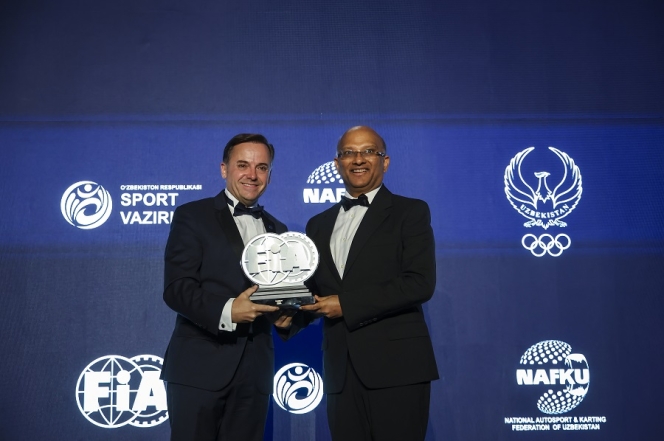
MRF Tyres has once again proven its motorsport pedigree by securing the 2025 FIA European Rally Championship Team Title. The official accolade was presented at the season-ending FIA Awards Gala in Tashkent, where Vice-Chairman and Managing Director Arun Mammen collected the trophy. This gala represents the pinnacle of the international motorsport calendar, formally recognising champions from across the discipline.
This victory marks the team’s third ERC crown, following previous successes in 2022 and 2023. It was earned through a campaign defined by remarkable consistency and adaptability across diverse rally stages. Strategic tyre choices and seamless coordination between the team’s personnel, engineers and driving crews were fundamental to this achievement, highlighting the programme’s overall strength and the reliability of its products.
The company has extended its appreciation to every individual who contributed to this result. The recognition at such a distinguished forum reinforces the company’s commitment to excellence and cements its position as a leading force on the global rally stage.
Mammen said, “We are deeply honoured to receive the Team Title at such a prestigious occasion. This award recognises not only the work of our engineers and staff, but also the spirit, dedication and resilience of the entire MRF Tyres organisation, both on and off the stages of the 2025 European Rally Championship. When preparation, performance and passion come together, tyres can make the difference. This trophy underlines our commitment and encourages us to continue delivering our very best in the seasons to come.”
BKT Unveils World-Class Sports Injury And Rehabilitation Centre At KEM Hospital
- By TT News
- December 16, 2025
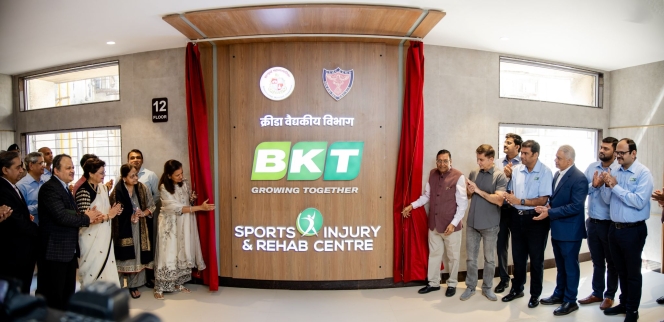
Balkrishna Industries Ltd (BKT Tires), a global leader in Off-Highway tyre manufacturing, has reinforced its commitment to India’s healthcare and sports development by enabling the establishment of a world-class Sports Injury and Rehabilitation Centre at King Edward Memorial (KEM) Hospital in Mumbai through its CSR arm, the BKT Foundation. Spread across more than 15,000 square feet within the hospital premises, the facility represents a significant addition to public healthcare infrastructure while responding to the growing needs of India’s evolving sports ecosystem.
Designed to serve athletes from diverse disciplines, the centre is expected to emerge as one of western India’s most comprehensive rehabilitation hubs within the public healthcare system. With the ability to support more than 1,000 athletes each year and facilitate over 500 specialised surgical procedures, it aims to accelerate recovery, enhance performance and help sportspersons prepare for competition at national and international levels.
Clinical leadership of the facility rests with Dr Roshan Wade, sports specialist and additional professor in the Orthopaedics Department, who will work alongside a multidisciplinary team of surgeons, physiotherapists, rehabilitation experts and nutrition professionals. Together, they will deliver integrated and end-to-end care under one roof, addressing both injury management and long-term physical conditioning.
The centre houses a fully equipped operation theatre complex with three advanced surgical rooms, a 20-bed inpatient ward and ICU-backed post-operative care. Its rehabilitation wing features high-end technologies including hyperbaric oxygen therapy, zero-gravity and underwater treadmills, virtual reality-based recovery systems and a specialised gait analysis laboratory. Outpatient services are supported by consultation rooms, in-house imaging such as X-ray and scannogram facilities and a wide range of interventional therapies.
The inauguration on 14 December 2025 was attended by senior leadership from BKT, municipal authorities and KEM Hospital, underscoring strong public–private collaboration. With an investment of approximately INR 200 million and a multi-year agreement ensuring equipment upkeep and infrastructure support, the project reflects BKT Foundation’s broader vision of strengthening healthcare capacity while nurturing India’s sporting potential.
Arvind Poddar, Chairman and Managing Director, BKT, said, “At BKT, we believe progress truly happens when communities move forward together. ‘Growing Together’ is more than a motto for us. It guides our decisions. By creating this centre with KEM Hospital and the BMC, we want to make world-class treatment accessible to every athlete. We are confident this facility will help many sportspersons return stronger.”
Vijayalaxmi Poddar, Chairperson, BKT-CSR committee, said, “This project reflects the values BKT stands for – Care, Dignity, Accessibility and Empowerment. Our goal was to create a space where healing is dignified and where every athlete feels supported at every stage of recovery. We want our youth to believe that their dreams are achievable, and we stand with them as they pursue excellence.”


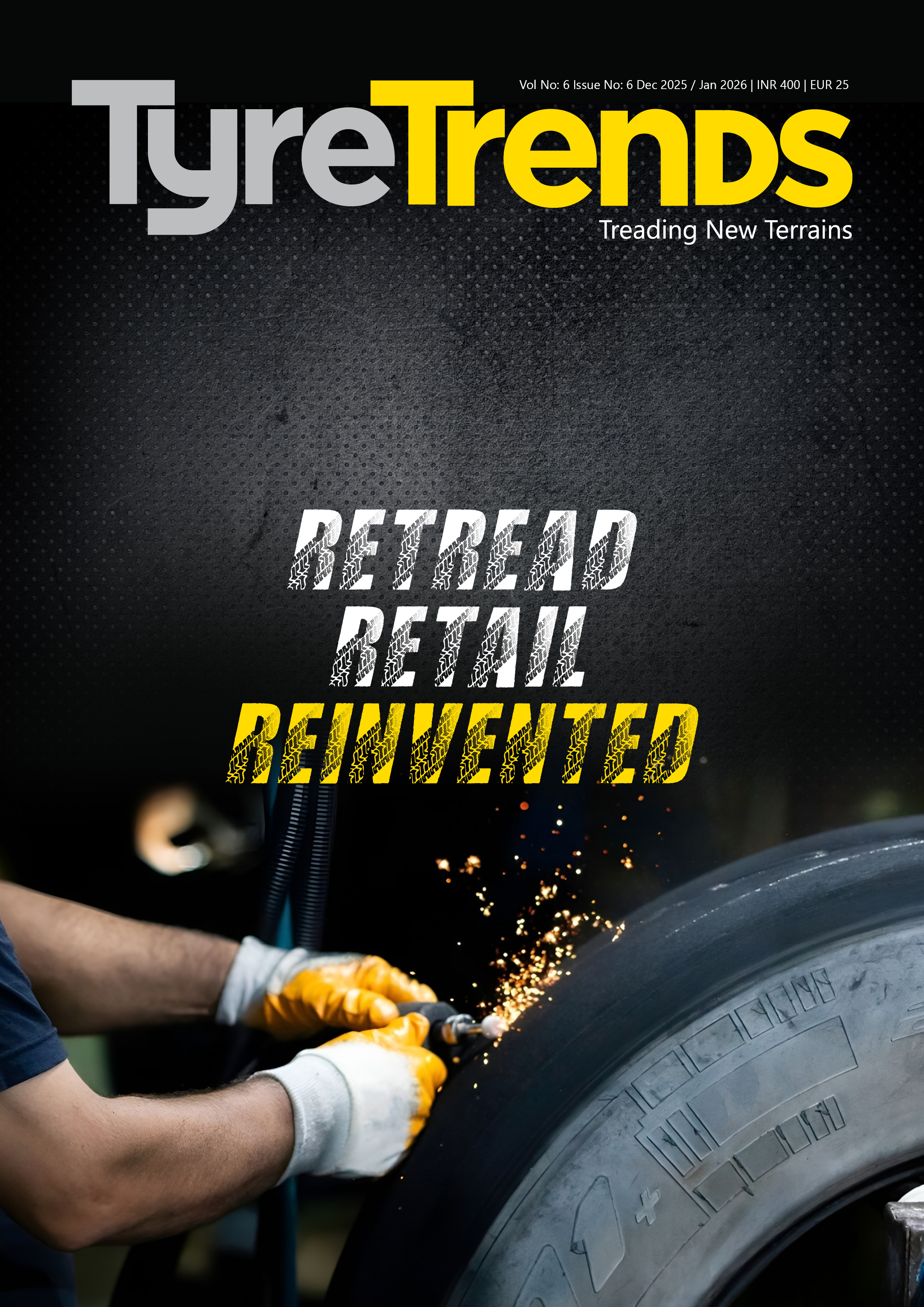



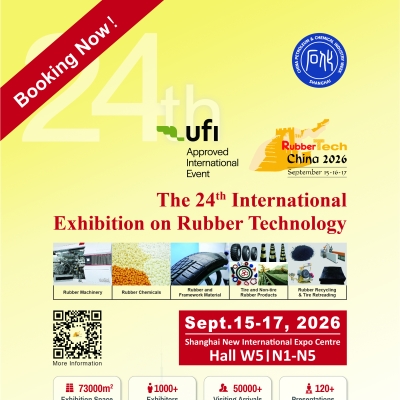
Comments (0)
ADD COMMENT